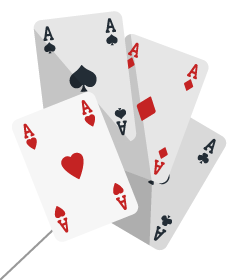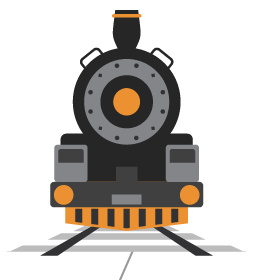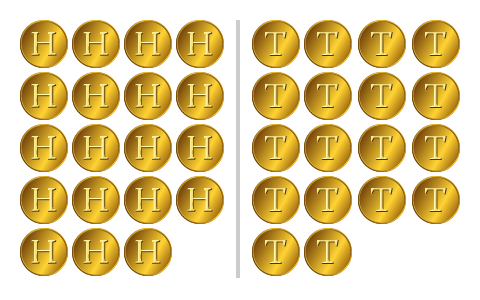Chance and Probability
Sometimes it happens that during rainy season, you carry a raincoat every day and it does not rain for many days. However, by chance, one day you forget to take the raincoat and it rains heavily on that day.
Sometimes it so happens that a student prepares 4 chapters out of 5, very well for a test. But a major question is asked from the chapter that she left unprepared. Everyone knows that a particular train runs in time but the day you reach well in time it is late!
You face a lot of situations such as these where you take a chance and it does not go the way you want it to. Can you give some more examples? These are examples where the chances of a certain thing happening or not happening are not equal. The chances of the train being in time or being late are not the same. When you buy a ticket which is wait listed, you do take a chance. You hope that it might get confirmed by the time you travel.
We however, consider here certain experiments whose results have an equal chance of occurring.
Getting a result
You might have seen that before a cricket match starts, captains of the two teams go out to toss a coin to decide which team will bat first.
What are the possible results you get when a coin is tossed? Of course, Head(H) or Tail(T).
Imagine that you are the captain of one team and your friend is the captain of the other team. You toss a coin and ask your friend to make the call. Can you control the result of the toss?
Can you get a head if you want one? Or a tail if you want that?
No, that is not possible. Such an experiment is called a random experiment. "Head" (or) "Tail" are the two outcomes of this experiment.
Try these
1. If you try to start a scooter, what are the possible outcomes?
Solution :
2. When a die is thrown, what are the possible outcomes?
Solution :
When you spin the wheel shown, what are the possible outcomes? (Outcome here means the sector at which the pointer stops).
- You have a bag with five identical balls of different colours and you are to pull out (draw) a ball without looking at it; list the outcomes you would get.
Think, Discuss and Write
In throwing a die:
Does the first player have a greater chance of getting a six?
Would the player who played after him have a lesser chance of getting a six?
Suppose the second player got a six. Does it mean that the third player would not have a chance of getting a six?
undefined
Equally likely outcomes:
A coin is tossed several times and the number of times we get head or tail is noted. Let us look at the result sheet where we keep on increasing the tosses:
| No. of Tosses | No. of heads | No. of tails |
|---|---|---|
| 50 | 27 | 23 |
| 60 | 28 | 32 |
| 70 | 33 | 37 |
| 80 | 38 | 42 |
| 90 | 44 | 46 |
| 100 | 48 | 52 |
Observe that as you increase the number of tosses more and more, the number of heads and the number of tails come closer and closer to each other. This could also be done with a die, when tossed a large number of times. Number of each of the six outcomes become almost equal to each other.
In such cases, we may say that the different outcomes of the experiment are equally likely. This means that each of the outcomes has the same chance of occurring.
What are Probabilities
A probability is a number between 0 and 1 which describes the likelihood of a certain event. A probability of 0 means that something is impossible; a probability of 1 means that something is certain.
For example, it is
The probability of rolling a 6 on a die, or picking a particular suit from a deck of cards is







Now drag the following events into the correct order, from likely to unlikely:
We often use probabilities and likelihoods in everyday life, usually without thinking about it. What is the chance of rain tomorrow? How likely is it that I will miss the bus? What is the probability I will win this game?
Tossing a (fair) coin has two possible outcomes, heads and tails, which are both equally likely. According to the equation above, the probability of a coin landing heads must be
Note that this probability is in between 0 and 1, even though only one of the outcomes can actually happen. But probabilities have very little to do with actual results: if we toss a coin many times we know that
Even events with tiny probabilities (like winning the lottery ![]() ) can still happen – and they do happen all the time (but to a very small proportion of the people who participate).
) can still happen – and they do happen all the time (but to a very small proportion of the people who participate).
Probabilities also depend on how much each of us knows about the event. For example, you might estimate that the chance of rain today is about 70%, while a meteorologist with detailed weather data might say the chance of rain is 64.2%.
Or suppose that I toss a coin and cover it up with my hands – the probability of tails is 50%. Now I peek at the result, but don’t tell you. I know for certain what has happened, but for you the probability is
There are many different ways to think about probabilities, but in practice they often give the same results:

The classical probability of landing heads is the proportion of possible outcomes that are heads.

The frequentist probability is the proportion of heads we get if we toss the coin many times.

The subjectivist probability tells us how strongly we believe that the coin will land heads.
Remember that while probabilities are great for estimating and forecasting, we can never tell what actually will happen.
Linking chances to probability
Consider the experiment of tossing a coin once. What are the outcomes? There are only two outcomes – Head or Tail. Both the outcomes are
Likelihood of getting a head is one out of two outcomes, i.e.,
In other words, we say that the probability of getting a head =
What is the probability of getting a tail?
Now take the example of throwing a die marked with 1, 2, 3, 4, 5, 6 on its faces (one number on one face). If you throw it once, what are the outcomes? The outcomes are:
Thus, there are
What is the probability of getting the outcome ‘2’?
It is
(i)What is the probability of getting the number 5?
(ii) What is the probability of getting the number 7?
(iii)What is the probability of getting a number 1 through 6?
Outcomes as events
Each outcome of an experiment or a collection of outcomes make an "event". For example: in the experiment of tossing a coin, getting a Head is an event and getting a Tail is also an event.
In case of throwing a die, getting each of the outcomes 1, 2, 3, 4, 5 or 6 is an event.
Is getting an even number an event? Since an even number could be 2, 4 or 6, getting an even number is also an event. What will be the probability of getting an even number?
It is
Example 3: A bag has 4 red balls and 2 yellow balls. (The balls are identical in all respects other than colour). A ball is drawn from the bag without looking into the bag. What is probability of getting a red ball? Is it more or less than getting a yellow ball?
Solution: There are a total numer of
Getting a red ball consists of
Therefore, the probability of getting a red ball =
In the same way the probability of getting a yellow ball =
Therefore, the probability of getting a red ball is
Try These
Suppose you spin the wheel
- (i) List the number of outcomes of getting a green sector and not getting a green sector on this wheel.
(ii) Find the probability of getting a green sector.
(iii) Find the probability of not getting a green sector.
Chance and probability related to real life
We talked about the chance that it rains just on the day when we do not carry a rain coat. What could you say about the chance in terms of probability? Could it be one in 10 days during a rainy season? The probability that it rains is then
The probability that it does not rain =
The use of probability is made in various cases in real life.
- To find characteristics of a large group by using a small part of the group.
For example, during elections ‘an exit poll’ is taken. This involves asking the people whom they have voted for, when they come out after voting at the centres which are chosen off hand and distributed over the whole area. This gives an idea of chance of winning of each candidate and predictions are made based on it accordingly.
- Meteorological Department predicts weather by observing trends from the data over many years in the past.
